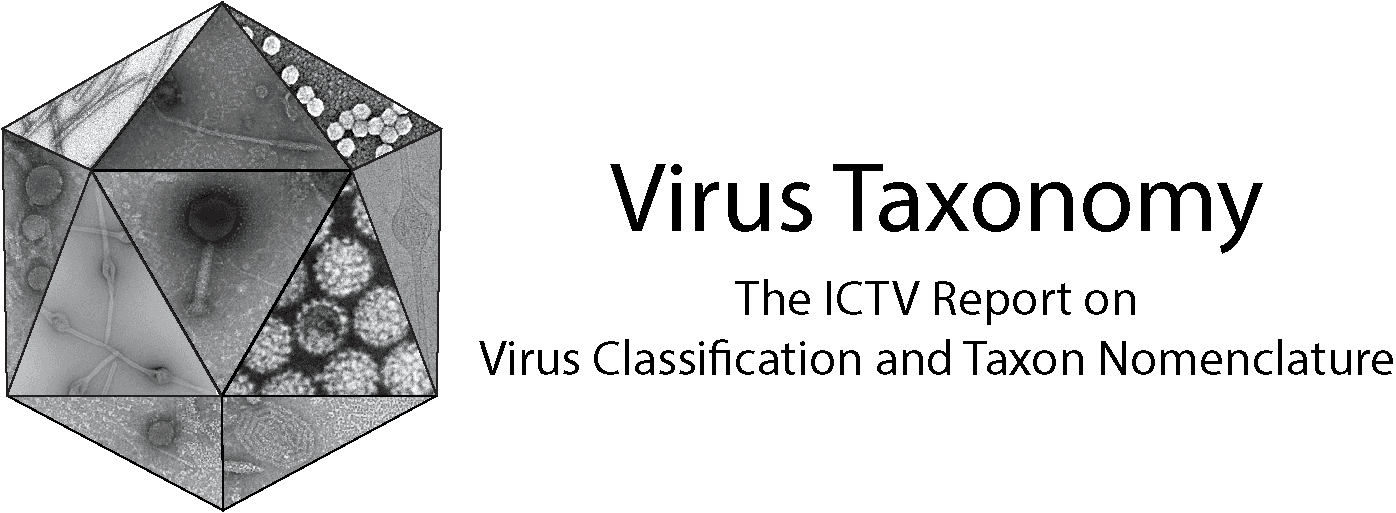Family: Adenoviridae
Genus: Aviadenovirus
Distinguishing features
Aviadenoviruses are serologically distinct from members of the other adenovirus genera and seem to only infect birds. Aviadenovirus genomes are generally longer than those of mastadenoviruses. The genomic organization of aviadenoviruses is characteristically different from that of adenoviruses in other genera (Figure 2 Adenoviridae) (Chiocca et al., 1996, Grgić et al., 2011, Kaján et al., 2012, Marek et al., 2014b).
Virion
Morphology
Fowl aviadenoviruses contain two fibers per vertex, with considerably different lengths in the case of fowl adenovirus 1 (FAdV-1) (Gelderblom and Maichle-Lauppe 1982). The morphology and number of fibers per vertex has not yet been determined for the other aviadenoviruses. However, 19 non-fowl aviadenovirus types are presently known with genomes having two fiber genes of different lengths (versus five types with one fiber gene) and these two fibers are expected to be different in length. The genomes with two different fibers are those of falcon adenovirus 1 (from American kestrel), FAdV-1, fowl adenovirus 4 (FAdV-4), fowl adenovirus 10 (FAdV-10), turkey adenovirus 1 (TAdV-1), turkey adenovirus 5 (TAdV-5), duck adenovirus 3 (DAdV-3), duck adenovirus 4 (DAdV-4), duck adenovirus 6 (DAdV-6), goose adenovirus 4 (GoAdV-4), pigeon adenovirus 1 (PiAdV-1), pigeon adenovirus 2 (PiAdV-2), psittacine adenovirus 1 (PsAdV-1), psittacine adenovirus 4 (PsAdV-4), psittacine adenovirus 12 (PsAdV-12), white-eyed parakeet adenovirus 2, owl adenovirus 1 (from Indian eagle-owl), tawny frogmouth adenovirus, great cormorant adenovirus (Zhang et al., 2016, Huang et al., 2020, Kobayashi et al., 2022, Athukorala et al., 2023, Karamendin et al., 2024b), black-naped oriole adenovirus (Zheng et al., 2022) and Timneh grey parrot adenovirus (Das et al., 2024). Other aviadenoviruses (fowl adenovirus 2, fowl adenovirus 3, fowl adenovirus 5, fowl adenovirus 6, fowl adenovirus 7, fowl adenovirus 8a, fowl adenovirus 8b, fowl adenovirus 9, fowl adenovirus 11, duck adenovirus 2 (DAdV-2), turkey adenovirus 4, crane adenovirus 1, Eurasian siskin adenovirus 2 and Eurasian scops owl adenovirus 1 have only one fiber gene (https://sites.google.com/site/adenoseq). To ascertain whether the non-fowl adenoviruses also possess two fibers on the same vertex, electron microscopy would be required. The 3D structures of the FAdV-1 long and short fibers have been established (Guardado-Calvo et al., 2007, El Bakkouri et al., 2008).
Physicochemical and physical properties
See discussion under family properties.
Nucleic acid
Aviadenovirus genomes are in general longer than those of mastadenoviruses. Genomes range between 38,694 bp (PsAdV-1) (Milani et al., 2018) and more than 46,029 (FAdV-4 isolate HBL_IBH4; the inverted terminal repeats [ITRs] are not clarified). The G+C composition of the (almost) complete sequences of aviadenovirus genomes varies between 34.2% (crane adenovirus 1, genome sequence is not complete) (Mukai et al., 2019) or 44.5% (GoAdV-4 isolate CH-FJZZ-202201) and 66.9% (TAdV-1) (Kaján et al., 2010). ITRs are between 39 (GoAdV-4) (Kaján et al., 2012) and 721 bp (DAdV-2, DAdV-3).
Proteins
See discussion under family properties.
Lipids
None reported.
Carbohydrates
See discussion under family properties.
Genome organization and replication
The genomic organization of aviadenoviruses is characteristically different from that of other adenoviruses (Figure 2 Adenoviridae) (Chiocca et al., 1996, Davison et al., 2003b, Marek et al., 2014b, Milani et al., 2018). The genes for proteins V and IX, as well as genes in mastadenovirus early regions E1 and E3, are missing. The E4 region may have been translocated from its position in mastadenovirus genomes, resulting in the gene encoding dUTP pyrophosphatase (dUTPase, not present in every mastadenovirus) being on the left genomic end, rather than on the right. (Alternatively, this gene may have been captured independently by ancestors of aviadenoviruses and mastadenoviruses.) The dUTPase upregulates the expression of type I interferons, but is not required for viral replication (Deng et al., 2016). The organization of the central part of the genome containing the late genes and the E2 region is similar to that of mastadenoviruses. The right and left ends of the genome contain several transcription units that are unique to aviadenoviruses, and some of the genes in them can be deleted for vector construction, although this may affect replication in cell culture or in vivo in some cases (Pei et al., 2019). The majority of genes and proteins from both ends of the genome have not yet been characterized in detail. GAM-1 (Gallus-anti morte protein, ORF8), located at the right genome end, has been demonstrated to have an anti-apoptotic effect and to activate the heat-shock response in the infected cell. In synergy with another protein encoded by ORF22, it binds the retinoblastoma protein and activates the E2F pathway (Lehrmann and Cotten 1999). Additional and as yet uncharacterized predicted gene products exhibit sequence homology to proteins of other viruses: the non-structural protein NS1 (also known as Rep) of parvoviruses (family Parvoviridae), or the lipase of Marek’s disease virus (family Orthoherpesviridae). Tandem repeats of different length and frequency at the right end of the genome are a common feature of aviadenoviruses. The fiber-1 of both FAdV-1 and FAdV-4 use the coxsackievirus and adenovirus receptor (CAR) for attachment to the cell (Tan et al., 2001, Pan et al., 2020). Fiber 2 of FAdV-4 has an influence on virulence and is now frequently used as vaccine antigen (Zhang et al., 2018, De Luca and Hess 2025).
Biology
Fowl adenoviruses have been associated with diverse disease patterns, of which inclusion body hepatitis can occur in various bird species (Schachner and Hess 2024). In chickens, gizzard erosion is mainly caused by FAdV-1. FAdV-4 is the etiological agent of hepatitis-hydropericardium syndrome mainly in chickens but also in ducks (Schachner et al., 2018). FAdV-2, FAdV-8a, FAdV-8b and FAdV-11 are frequently reported from inclusion body hepatitis in broilers (Kiss et al., 2021, Niu et al., 2022). Goose adenovirus 5 seems to have a role in hepatitis and hydropericardium syndrome of goslings (Ivanics et al., 2010). “Adenoviruses” have been proposed as important pathogens of racing pigeons. They do exist in domestic pigeons but their role in a specific disease has only been shown for PiAdV-1 (Agnihotri et al., 2021, Yang et al., 2025). Recently, a psittacine aviadenovirus associated with severe necrotising hepatitis in a captive Timneh grey parrot was described (Das et al., 2024). Aviadenoviruses have been suggested to be pathogenic also in Muscovy duck, parrots and other exotic birds (Zhang et al., 2016, Das et al., 2017, Karamendin et al., 2024b, Schachner and Hess 2024). A very severe respiratory disease in Alagoas curassows caused by FAdV-1 underlines the risk of virus spread from farmed poultry to wildlife species (Marques et al., 2019). Other aviadenoviruses are infrequently reported in connection with disease in their hosts.
FAdV-1 (CELO virus), FAdV-4, FAdV-9 and FAdV-10 have been studied for their feasibility as gene delivery vectors (Corredor et al., 2017, Pan et al., 2021).
Antigenicity
Aviadenoviruses possess no complement-fixing antigen in common with the members of other genera. Regarding serotype specificity, there are fowl adenovirus isolates that are not easily identifiable by serum neutralization which may be the result of recombinations of strains (Schachner et al., 2019). On the other hand, strains that are considerably distinct genetically still may belong to the same serotype (Kaján et al., 2022). The chimeric fibers of FAdV-4 and -11 seem to raise adequate antibody response to protect chickens against hepatitis-hydropericardium syndrome and inclusion body hepatitis (De Luca et al., 2022).
Species demarcation criteria
Species designation depends on at least two of the following characteristics:
- Phylogenetic distance (>10–15%, based on maximum likelihood analysis of the pol amino acid sequence)
- Genome organization (characteristically in the right terminal region)
- Host range
- Nucleotide composition
- Cross-neutralization
- Pathogenicity
For example, the fowl adenovirus serotypes can be grouped into five species on the basis of phylogeny, genome organization and the lack of significant cross-neutralization (Marek et al., 2016, Kaján et al., 2019), and turkey aviadenoviruses have been grouped into three species so far (Marek et al., 2014a). The introduction of types FAdV-8a and FAdV-8b was deemed necessary because of the inconsistency in the type-numbering scheme used in different countries and continents over the years, but this designation does not reflect any closer phylogenetic or serologic relation between the two serotypes.
Related, unclassified viruses
| Virus name | Accession number
| Abbreviation
|
| bar-headed goose adenovirus | PP331817 | |
| black-headed gull adenovirus | PP319110 | |
| black noddy (Charadriiformes) adenovirus | OL436125 | |
| black-tailed gull adenovirus | PP319106 | |
| brown booby (Suliformes) adenovirus | OL436128 | |
| brown noddy (Charadriiformes) adenovirus | OL436138 | |
| common kestrel adenovirus 1 | OL603910 | |
| Darwin's finch adenovirus 1 (small ground finch) | PV739275 | |
| Darwin's finch adenovirus 2 (medium ground finch) | PV739277 | |
| eastern yellow robin adenovirus | MN238650 | |
| Eurasian blackcap adenovirus 2 | OL603912 | |
| Eurasian curlew adenovirus | PP331826 | |
| Eurasian sparrowhawk adenovirus 1 | OL603909 | |
| European greenfinch adenovirus strain 48164-T3 | MN380554 | |
| falcated duck adenovirus | PP319133 | |
| ferruginous duck adenovirus | PP331833 | |
| Galapagos flycatcher adenovirus | PV739271 | |
| great egret (Pelecaniformes) adenovirus | PP319152 | |
| great spotted woodpecker adenovirus 1 | OL603907 | |
| great tit adenovirus 4 strain 47292 | MN380547 | |
| gull adenovirus | KC309438 | |
| hawfinch adenovirus 1 | OL603904 | |
| lesser black-backed gull adenovirus | PP319131 | |
| lesser whitethroat (Passeriformers) adenovirus 1 | OL603911 | |
| long-billed plower (Charadriiformes) adenovirus | PP319144 | |
| marten-associated adenovirus 1 | KY705358 | |
| masked booby (Suliformes) adenovirus | OL436133 | |
| myna adenovirus | OK334627 | |
| neotropic cormorant adenovirus | KY769942 | |
| Pacific golden plover (Charadriiformes) adenovirus 1 | PP319148 | |
| pied avocet (Charadriformes) adenovirus | PP319057 | |
| pigeon adenovirus 3 | KX555530 | PiAdV-3 |
| red-backed shrike adenovirus 1 | OL603900 | |
| red-crested pochard (Anseriformes) adenovirus | PP319147 | |
| red-footed booby (Suliformes) adenovirus | OL436134 | |
| relict gull adenovirus | PP319101 | |
| ruff (Charadriiformes) adenovirus | PP319140 | |
| short-eared owl adenovirus | PP319058 | |
| smooth billed ani adenovirus 1 | MN540448 | |
| sooty tern (Charadriiformes) adenovirus | OL436129 | |
| song thrush adenovirus 1 | OL603899 | |
| swan goose adenovirus | PP319175 | |
| Timneh grey parrot adenovirus 1 (proposed) | OR096706 | |
| turkey adenovirus 2 | GU936708 | TAdV-2 |
| vitelline masked weaver adenovirus strain 39658 | MN380540 | |
| white-backed woodpecker adenovirus | MT138102 | |
| yellowhammer adenovirus 1 | OL603902 |
Virus names and virus abbreviations are not official ICTV designations.
“Proposed” indicates that Timneh grey parrot adenovirus 1 has been proposed to the ICTV in 2025 as founding a new species (“Aviadenovirus cinerei”). Many aviadenoviruses have been detected by consensus PCR (Kaján 2016, Mukai et al., 2019, Verdugo et al., 2019, Jejesky de Oliveira et al., 2020, Rinder et al., 2020, Vaz et al., 2020, Harrach et al., 2023). Other sequences have been recovered by metagenomics (Teske et al., 2017, Vibin et al., 2018, Vibin et al., 2020, Zheng et al., 2022, Zheng et al., 2023).

